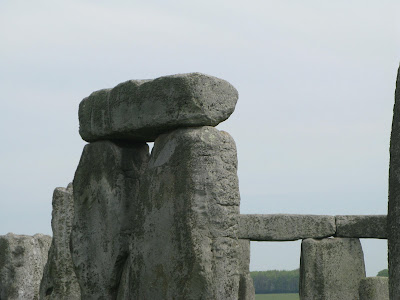When I recently returned to England one of the first places that I wanted to visit was Stonehenge. My cousins live about 30 miles from the area and we usually make the sojourn together. I am always filled with wonder at the mystery of this place.
STONEHENGE

The image above depicts the archaeological version of what Stonehenge
looked like two thousand years ago.
Stonehenge is a powerful reminder of the once-great peoples of the late Stone and Bronze Ages. Erected between 3,000 BC and 1,600 BC, a number of the stones were carried hundreds of miles over land and sea, while antlers and bones were used to dig the pits that hold the stones their ultimate purpose remains a fascinating and enduring mystery.

Here we have an ariel view, by National Geographic,
of Stonehenge today.
Mystery surrounds this 5,000 year old monument in the centre of the World Heritage Site. When you visit this prehistoric site it is hard to decide whether Stonehenge was a place of sun worship, a healing sanctuary, a sacred burial site, or something different altogether!

Stonehenge stands as an enduring testimony to the people who built it, in several phases between 3,000 and 1,600 BC. An amazing feat of engineering and arguably the most sophisticated stone circle in the world.
They provide a complimentary audio tour which tells you all about the history of the site.
Every time I visit I learn a little more than the time before. This is one of the most intriguing sites in the British Isles.

The surrounding landscape is also fascinating. It contains huge prehistoric monuments, stretching over several miles. Many of the earthen monuments have been eroded away and often, only traces remain above ground.

The stones were built by three different cultures, Windmill, First Wessex and the Beakers - so named because when they buried their dead they had their pots interred with them.
The Bluestones are the smaller inner stones, which originate from Preselli mountains in Wales, and when they become wet they turn blue.

Stonehenge is not the largest stone circle in the world but it is the only one that has lintels around the top, making this unique.
There is no explanation as to why this site was chosen. Various theories have been put forward but no conclusive evidence has been found to support them.

A common complaint is that there are now ropes erected around the stones to prevent people climbing on them. They were put in place in 1978 to help protect the stones from further damage.
A lot of the original stones have been taken by our ancestors to build their houses and roads. Also, a lot of stones have been chipped away by visitors and taken away as souvenirs over the past couple of hundred years, therefor there has to be some protection in place to preserve the site.
*****
I never fail to enjoy this visit. I have written about the history here, but there is another aspect of this place that is easier to experience than to accurately write about. I am referring to the feeling that comes over myself and most visitors as we are standing looking at the sacred circle.
It is hard to imagine the ancient people who mapped the course of the sun and moon to build this monument. To view the burial mounds where they buried their leaders. This place is the center of one of the world's earliest cultures. They actually continued to build this for over two thousand years. They didn't give up until it was finished.
They dragged the larger stones, 30 Sarsens (sandstone uprights), from the Marlborough Downs , 19 miles away. Each one weighing over 25 tons. The smaller stones, known as the Bluestones, are from the mystical Preseli Mountains in Wales, 240 miles away.
What was their technology? How did they do that? What was their motivation to keep at it for so many years? As the tour guides say "It still remains a mystery today."
While we were there we met some colorful people.
More about this site soon..................
*****
photos (unless indicated) by peacesojourner



2 comments:
I would LOVE to see Stonehenge!
There is at least one explanation for the stone figures and decline in population in Jared Diamond's book Collapse. He thinks that building the monoliths became a game of oneupsmanship, with each village building bigger and bigger monoliths. In order to transport them, they had to cut down trees. Eventually the whole island was deforested and people could no longer survive there, so they left!
Not vety romantic or spiritual, but....
Great post- I live not too far from Stonehenge; I was lucky enough to see it when there were no ropes or restrictions and you could wander around the stones.
I think maybe the comment above refers to the Easter Island figures :) ?
Post a Comment